Turquoise as a Mineral and Gemstone (original) (raw)
A gem material that has been held in highest regard for thousands of years.
Author: , PhD, GIA Graduate Gemologist
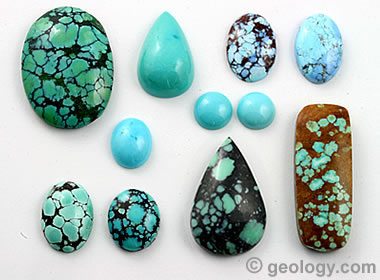
Turquoise cabochons: A diverse collection of turquoise cabochons from various locations. From left to right in the upper row: a greenish blue turquoise cabochon with black matrix from China; a teardrop-shaped, slightly greenish blue turquoise cabochon from Arizona's Sleeping Beauty Mine; and, two sky-blue turquoise cabochons with chocolate brown matrix from the Altyn-Tyube Mine in Kazakhstan. In the center row: a small sky-blue turquoise cabochon from the Kingman Mines in Arizona; and, two small round sky-blue cabochons from the Sleeping Beauty Mine of Arizona. In the bottom row: two small cabochons with black matrix from unknown mines in Nevada; a teardrop-shaped cabochon with slightly greenish blue turquoise in black matrix from the Newlanders Mine in Nevada; and, a rectangular cabochon of slightly greenish blue turquoise in reddish brown matrix from the #8 Mine in Nevada.
What is Turquoise?
Turquoise is an opaque mineral that occurs in beautiful shades of blue, bluish green, green, and yellowish green. It has been treasured as a gemstone for thousands of years. Isolated from one another, the ancient people of Africa, Asia, South America and North America independently made turquoise one of their preferred materials for producing gemstones, inlay, and small sculptures.
Chemically, turquoise is a hydrous phosphate of copper and aluminum (CuAl6(PO4)4(OH)8·4H2O). Its only important use is in the manufacture of jewelry and ornamental objects. However, in that use it is extremely popular - so popular that the English language uses the word "turquoise" as the name of a slightly greenish blue color that is typical for high-quality turquoise.
Very few minerals have a color that is so well known, so characteristic, and so impressive that the name of the mineral becomes so commonly used. Only three other minerals - gold, silver, and copper - have a color that is used more often in common language than turquoise.
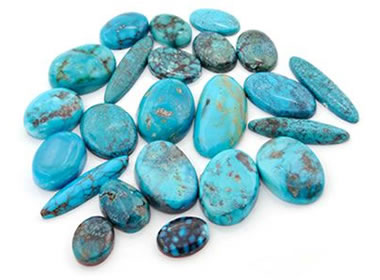
Turquoise cabochons: Turquoise cabochons from many parts of the world, showing a diversity of color and matrix. Image copyright iStockphoto, IrisGD.
Table of Contents
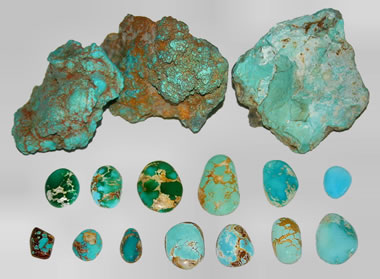
Turquoise Rough and Cabochons: A small collection of turquoise cabochons and pieces of uncut turquoise. The photographer and owner of the turquoise is Reno Chris of Nevada Outback Gems. Click to enlarge.
Turquoise Colors
Blue minerals are rare, and that is why turquoise captures attention in the gemstone market. The most desirable color of turquoise is a sky blue or robin's-egg blue. Some people inappropriately describe the color as "Persian blue" after the famous high-quality material mined in the area that is now known as Iran. Using a geographic name with a gem material should only be done when the material was mined in that locality.
After blue, bluish green stones are preferred, with green and yellowish green material being less desirable. Departure from a nice blue color is caused by small amounts of iron substituting for aluminum in the turquoise structure. The iron imparts a green tint to the turquoise in proportion to its abundance. The color of turquoise might also be altered by small amounts of iron or zinc substituting for copper in the turquoise structure.
Some turquoise contains inclusions of its host rock (known as matrix) that appear as black or brown spider-webbing or patches within the material. Many cutters try to produce stones that exclude the matrix, but sometimes it is so uniformly or finely distributed through the stone that it cannot be avoided. Some people who purchase turquoise jewelry enjoy seeing the matrix within the stone, but as a general rule, turquoise with heavy matrix is less desirable.
Some turquoise localities produce material with a characteristic color and appearance. For example, the Sleeping Beauty Mine is known for its light blue turquoise without matrix. Much of the turquoise from the Kingman Mine is bright blue with a spider web of black matrix. The Morenci Mine produces a lot of dark blue turquoise with pyrite in the matrix. Much of the Bisbee turquoise has a bright blue color with a chocolate brown matrix. People who know turquoise can often, but not always, correctly associate a stone with a specific mine.
The best way to learn about minerals is to study with a collection of small specimens that you can handle, examine, and observe their properties. Inexpensive mineral collections are available in the Geology.com Store. Image copyright iStockphoto / Anna Usova.
Turquoise Jewelry Care
Turquoise has a lower-than-ideal hardness and durability for use in certain types of jewelry. Although the gem is frequently used in rings, bracelets, and belt buckles, these uses place the gem at risk for abrasion and impact.
Smart jewelry design will surround the gem with a durable bezel that protects the sides of the gem from abrasion and impact. The bezel should be high enough to also protect the face of the gem. Even if the gem is protected by a bezel, turquoise jewelry should be worn with care and respect. Avoid wearing it during activities that put the gem at risk, and store it where it will not be scratched by other items of jewelry.
Turquoise is often porous, with the ability to absorb liquids. These liquids can include perspiration, body oil, cleaning products, or any liquid that accidentally comes in contact. Once absorbed, these liquids can damage the turquoise or alter its color. If contact with cosmetics or potentially damaging liquid occurs, the turquoise should be washed with a soft cloth that is dampened with a very mild soap solution, followed by cleaning with a soft cloth that has been dampened with plain water. Then, after the turquoise is dry, store it in a jewelry box away from bright light or heat.
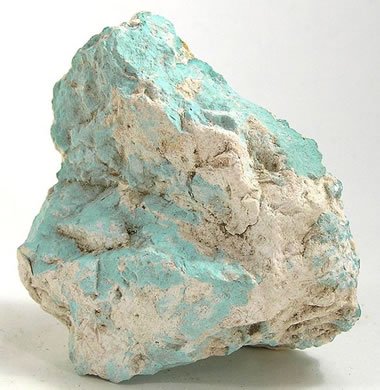
Turquoise rough: A specimen of rough sky blue turquoise in host rock from Mohave County, Arizona. Specimen and photo by Arkenstone / www.iRocks.com.
Turquoise Occurrence
Turquoise is rarely found in well-formed crystals. Instead it is usually an aggregate of microcrystals. When the microcrystals are packed closely together, the turquoise has a lower porosity, greater durability, and polishes to a higher luster. This luster falls short of being "vitreous" or "glassy." Instead many people describe it as "waxy" or "subvitreous."
Turquoise forms best in an arid climate, and that determines the geography of turquoise sources. Most of the world's turquoise rough is currently produced in the southwestern United States, China, Chile, Egypt, Iran, and Mexico.
In these areas, rainfall infiltrates downward through soil and rock, dissolving small amounts of copper. When this water is later evaporated, the copper combines with aluminum and phosphorus to deposit tiny amounts of turquoise on the walls of subsurface fractures.
Turquoise can also replace the rock in contact with these waters. If the replacement is complete, a solid mass of turquoise will be formed. When the replacement is less complete, the host rock will appear as a "matrix" within the turquoise. The matrix can form a "spider web," "patchy" design, or other pattern within the stone.
| Physical Properties of Turquoise | |
|---|---|
| Chemical Classification | Phosphate |
| Color | Sky blue (the most desirable as a gemstone), blue, bluish green, green, yellowish green; often with brown, gray, or black matrix, as spider-webbing or background color. |
| Streak | Bluish white to greenish white |
| Luster | Waxy to subvitreous. Dull or chalky when weathered. |
| Diaphaneity | Opaque |
| Cleavage | Perfect, but rarely seen because of the small grain size of most specimens |
| Mohs Hardness | 5 to 6 (often lower because of porosity or exposure to weathering) |
| Specific Gravity | 2.5 to 2.9 (variable because of porosity and other minerals included as matrix) |
| Diagnostic Properties | Color, refractive index |
| Chemical Composition | CuAl6(PO4)4(OH)8·4H2O |
| Crystal System | Triclinic |
| Uses | Gemstone, small sculptures, decorative stone |
Physical Properties of Turquoise
The physical properties of turquoise are valuable for its identification. They are also valuable information for the care of turquoise jewelry. Important properties are summarized in the accompanying table.
Weathering can significantly alter the physical properties of turquoise. Weathered turquoise might still have a desirable color, but its hardness and durability are reduced. This turquoise cannot be cut into useful cabochons or beads. Weathered turquoise is often crushed and used to make "composite" or "reconstituted" turquoise described in the "Natural Turquoise and Turquoise Treatments" section below.
| Turquoise Group Minerals | |
|---|---|
| Mineral | Chemical Composition |
| Turquoise | CuAl6(PO4)4(OH)8·4H2O |
| Aheylite | (Fe,Zn)Al6(PO4)4(OH)8·4H2O |
| Chalcosiderite | Cu(FeAl)6(PO4)4(OH)8·4H2O |
| Faustite | (Zn,Cu)Al6(PO4)4(OH)8·4H2O |
| Planerite | Al6(PO4)2(OH)8·4H2O |
The Turquoise Group of Minerals
The turquoise group consists of five triclinic minerals. These minerals are very similar in chemical composition, crystal structure, physical properties and often in appearance. Members of the group are: turquoise, aheylite, chalcosiderite, faustite, and planerite. Their compositions are listed in the accompanying table.
Notice that the members of the turquoise group have very similar chemical compositions. In these minerals iron often substitutes for aluminum, and copper often substitutes for zinc or iron. Because they are so similar and have ranges of composition, these minerals are often misidentified. As a result, some material sold as turquoise is actually another mineral member of the turquoise group.
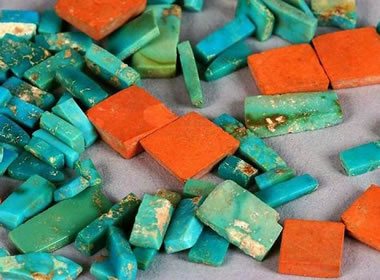
Turquoise and argillite inlay pieces: A collection of Ancestral Puebloan (Anasazi) turquoise and orange argillite inlay pieces from Chaco Canyon National Historical Park in New Mexico. These pieces date from about 1020-1140 CE and show the typical materials used in the ancient Chacoan bead and inlay industry. Public domain image from the National Park Service.
Turquoise in the United States
Most of the turquoise production in the United States has been located in the arid southwest, and most of that production has been in or around deposits of copper. Arizona, New Mexico, and Nevada have all held the position of the leading turquoise-producing state. New Mexico held that position until the 1920s, Nevada held the position until the 1980s, and Arizona is currently the leading state. Significant amounts of turquoise have been produced in California, Colorado, Utah, Texas, and Arkansas.
Most of the turquoise mined in the United States is a byproduct of copper production. The large open-pit copper mines excavate down through the shallow rock units where the turquoise is formed. When turquoise is encountered, the quantity and quality of the material is assessed, and, only if warranted, will a temporary effort be made to recover the gem material. If the value of the turquoise is worth disrupting a billion dollar mining operation, it will be mined. The mining could be done by copper company employees, but the job often goes to outside miners who come to the mine at a moment's notice, quickly recover the turquoise, and get out of the way!
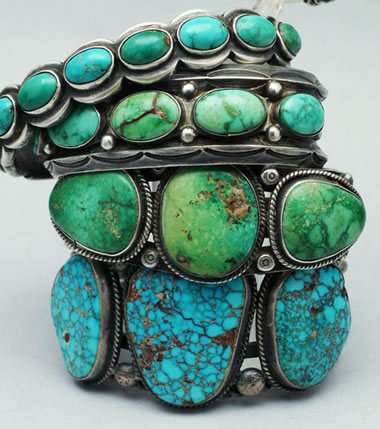
Turquoise jewelry: Navajo bracelets made with silver and turquoise. Image by Silverborders, used here under a Creative Commons license.
Turquoise Jewelry and Art
The earliest record of turquoise being used in jewelry or in ornaments is from Egypt. There, turquoise has been found in royal burials over 6000 years old. About 4000 years ago, miners in Persia produced a blue variety of turquoise with a "sky blue" or "robin's-egg blue" color. This material was very popular and traded through Asia and into Europe. This is the source of the term "Persian Blue" color.
In North America the earliest known use of turquoise was in the Chaco Canyon area of New Mexico, where the gem was used over 2000 years ago. Ancient artists produced beads, pendants, inlay work, and small sculptures.
Rough turquoise and turquoise objects were held in high regard by Native Americans and were traded widely. This spread North American turquoise across the southwest and into South America. These early Native American jewelry designs were simple, and the turquoise was not set in metal findings.
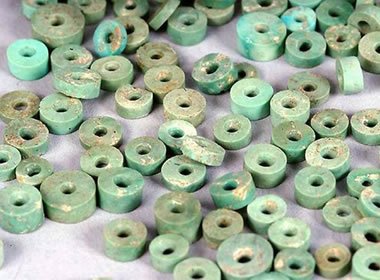
Turquoise beads: A collection of Ancestral Puebloan (Anasazi) turquoise beads from Chaco Canyon National Historical Park in New Mexico. These pieces date from about 1050-1100 CE and show the typical materials used in the ancient Chacoan bead and inlay industry. Public domain image from the National Park Service.
In the late 1800s, Native American artists began using coin silver to make jewelry. This work evolved into the turquoise and sterling silver style of Native American jewelry that is popular today.
The demand for turquoise and turquoise jewelry rises and falls over time. In 1912, turquoise was named as one of the original modern birthstones for the month of December. This gave the gem a small boost in popularity which continues to the present.
In the United States there was a surge in turquoise demand that began in the 1970s and declined in the 1980s. Demand for turquoise jewelry is always highest in the southwestern states where turquoise mining and Native American artists make turquoise a distinctive part of the local culture.
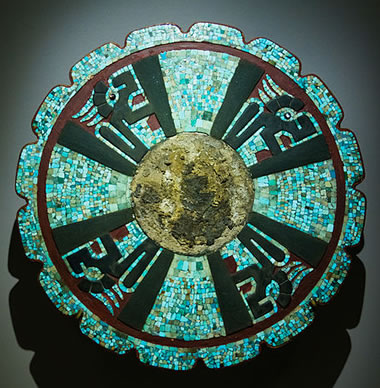
The Disk of Chichen Itza is a Mayan artwork, made about 1000 years ago, in what is today the Yucatan State of Mexico. It consists of a central pyrite mirror, which has since oxidized, surrounded by a mosaic depicting four dragons. The design is an inlay work made of slate, coral, shell, and turquoise. The disk was found in the throne seat of Chac Mool at Chichen Itza, and today it is in the collection of the Quai Branly Museum, Paris, France. The photograph is a public domain image by Jebulon.
Natural and Treated Turquoise
Only a small amount of turquoise that is mined today can be used to cut finished stones or make jewelry without some type of treatment. These treatments make the turquoise stable enough for cutting, durable enough for jewelry, or improve its color and marketability.
Untreated turquoise is a rare commodity. The rough, the stones cut from it, and jewelry made from it are special and held in highest regard by many people. Untreated turquoise is hard to find, and lots of people want it for a variety of reasons.
The different types of turquoise, based upon their treatments, are described below. They are listed from top to bottom in order of their desirability.
Natural Untreated Turquoise is the name for turquoise that is fashioned into cabochons, beads or other items and used to manufacture jewelry without any type of treatment. It is the most highly desirable type of turquoise, especially when it has an attractive color. You are most likely to find it for sale in stores that specialize in fine turquoise jewelry, those that sell high-quality one-of-a-kind items, or those that specialize in natural, untreated gems. Sellers of natural untreated turquoise frequently use the fact that no treatment has been done as a selling point.
Stabilized Turquoise is the name used for turquoise that has been impregnated with a polymer or other binding material to make it durable enough for cutting and use in jewelry. Straight from the mine this turquoise is too soft, too porous, too fractured or too fragile for manufacturing. Stabilized turquoise can be cut into beautiful beads and cabochons. It is the most common type of turquoise in today's gem and jewelry market. It is widely accepted because the supply of natural turquoise is much smaller than the demand from people who want it. The fact that an item is made from stabilized turquoise should always be disclosed to the buyer prior to sale, and the price should be lower than untreated turquoise of similar quality.
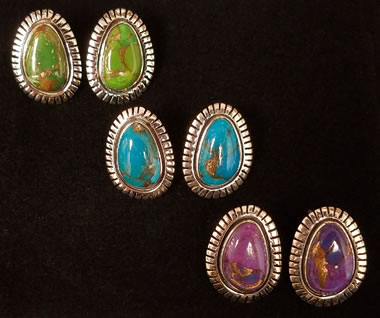
Composite Turquoise: These earrings are made with composite turquoise. Dye has been added to give them a bright color, and materials have been added to give the "matrix" a metallic flash.
Composite or Reconstituted Turquoise is made from small pieces of turquoise that are mixed with a polymer and cast into block-shaped pieces. Finely crushed turquoise and some non-turquoise materials are sometimes included. The blocks are then sawn into small pieces that are used to cut cabochons, beads and other items. This material is often called “block turquoise” because of this manufacturing method. Sellers who pride themselves on selling only natural gems frequently decline to sell reconstituted turquoise. Some gem identification labs decline to call this material "turquoise" and instead label it as a "man-made product." At the same time, some vendors are glad to sell these materials and jewelry made from them because they often have an attractive appearance and a low price.
Dyed Turquoise is exactly that. Turquoise is a porous material and easily accepts dye. The dye is used to modify the turquoise to a more marketable color. Dye can also be used to produce an outrageous color. Composite and reconstituted turquoise are the most commonly dyed materials. Dye can be used to color the turquoise or to color the polymer binding material. Sometimes black or brown dye is used to alter the color of matrix material to make it more obvious and uniform. Dyed turquoise is always worth less than untreated material of a similar color and quality.
ADVERTISEMENT
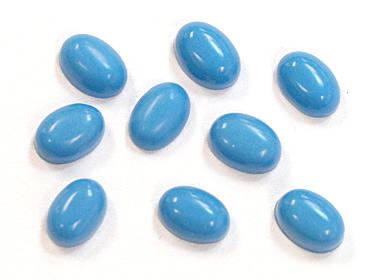
Synthetic Turquoise Cabochons: Cabochons made from synthetic turquoise produced in Russia. These stones are 7mm x 5mm ovals.
Synthetic and Imitation Turquoise
A small amount of synthetic turquoise was produced by the Gilson Company in the 1980s, and some of their material was used to make jewelry. It was produced in a sky blue color, sometimes with a gray spider webbing. It was a ceramic product with a composition similar to natural turquoise.
Synthetic turquoise and turquoise simulants have been produced in Russia and China since the 1970s. Both countries are prolific producers. The material is used to make cabochons, beads, small sculptures, and many other items. A photo on this page shows some synthetic turquoise cabochons made in Russia.
There are many different glass, plastic, and ceramic materials with an appearance similar to turquoise. Many of these can easily be distinguished from turquoise by testing their hardness, specific gravity, refractive index, or other properties.
Turquoise: Real or Fake?
Look-Alike Materials
Howlite and magnesite are light gray to white minerals that often have markings that resemble the spider webbing seen in some turquoise. They can be dyed a turquoise blue color that makes them look very similar to natural turquoise. These dyed stones fooled many people when they first entered the marketplace and still are mistaken for genuine turquoise by unfamiliar buyers.
Dyed stones have damaged the market for genuine turquoise. They have been purchased with the thought that they were turquoise by many people and have produced uncertainty in the mind of many jewelry buyers. This causes some people to avoid turquoise jewelry.
Today dyed howlite and magnesite are still used to make mass-produced beads, cabochons, tumbled stones, and other turquoise look-alike items. They are almost ubiquitous in the marketplace. Be cautious if you see turquoise with a wonderfully blue and very uniform color.
| R.I. Solves Some Turquoise Confusion | |
|---|---|
| Mineral | Refractive Index |
| Magnesite | 1.509 - 1.700 (birefringence blink) |
| Variscite | 1.560 - 1.590 |
| Howlite | 1.586 - 1.605 |
| Turquoise | 1.610 - 1.650 |
| Chalcosiderite | 1.775 - 1.844 |
Ending Some of the Turquoise Confusion
Howlite and magnesite can easily be separated from turquoise using a refractometer. They have different refractive indexes. If you are willing to do a destructive test, the blue dye used to color howlite and magnesite generally does not penetrate very deep. If lightly dyed, scratching the back of a cabochon with a pin will often reveal a white interior. If the piece is heavily dyed, scratching deeper or breaking an edge might be required to determine if the piece has been dyed.
Several minerals are found where turquoise is expected, look similar to turquoise, are misidentified as turquoise, and often enter the gem and jewelry market labeled as turquoise. Variscite, chalcosiderite, and magnesite are examples. A yellow, white, brown or green color should be an immediate clue that these might not be turquoise. An easy-to-do refractive index test will quickly separate all of these minerals from turquoise. Turquoise has a refractive index of 1.61 to 1.65. All of these other minerals are different as shown in the accompanying table.
Find Other Topics on Geology.com:
 Rocks: Galleries of igneous, sedimentary and metamorphic rock photos with descriptions. Rocks: Galleries of igneous, sedimentary and metamorphic rock photos with descriptions. |
 Minerals: Information about ore minerals, gem materials and rock-forming minerals. Minerals: Information about ore minerals, gem materials and rock-forming minerals. |
|---|---|
 Volcanoes: Articles about volcanoes, volcanic hazards and eruptions past and present. Volcanoes: Articles about volcanoes, volcanic hazards and eruptions past and present. |
 Gemstones: Colorful images and articles about diamonds and colored stones. Gemstones: Colorful images and articles about diamonds and colored stones. |
 General Geology: Articles about geysers, maars, deltas, rifts, salt domes, water, and much more! General Geology: Articles about geysers, maars, deltas, rifts, salt domes, water, and much more! |
 Geology Store: Hammers, field bags, hand lenses, maps, books, hardness picks, gold pans. Geology Store: Hammers, field bags, hand lenses, maps, books, hardness picks, gold pans. |
 |
 Diamonds: Learn about the properties of diamond, its many uses, and diamond discoveries. Diamonds: Learn about the properties of diamond, its many uses, and diamond discoveries. |
